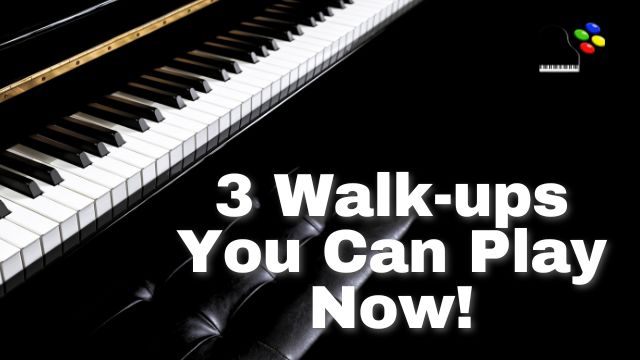Have you ever noticed a nchord progressio that has the quality of walking up from one chord to another? I’m sure you’ve heard of them. I want to share with you three walk-ups that you can play right now.
A walk-up is an ascending bassline that transitions from one chord to another, usually stepwise through the key you’re playing in.  They add momentum to the chord progression and clearly define where the chord is moving to.
They add momentum to the chord progression and clearly define where the chord is moving to.
Walk-ups are played in all styles of music so I want to share a few with you as an example of a few styles you can play them in.
The walk up of a bassline is very simple to understand. Let’s say you’re in the key of C Major. Like any other key, it contains 7 notes that are numbered 1 thru 7 per the *number system*.
Key of C Major

With the key being numbered, the walk-up is referred to numerically as it refers to the bassline.
A walk-up could be something like 1-4-5. The bass notes would be these tones: Or the walk-up may be 4-5-6
Or the walk-up may be 4-5-6
The bass notes will correspond with these numbers but not necessarily the diatonic chords that coincide with them.
For example, the 3 chord could be the E minor chord, or it may be the C Major over E slash chord.
E minor is the 3 chord. C Major is the 1 chord.
C Major is the 1 chord. Just keep in mind that with walk-ups, the numbers are referring to the bass notes of the ascending chord. The chord that matches the bass note could be any chord that fits within it.
Just keep in mind that with walk-ups, the numbers are referring to the bass notes of the ascending chord. The chord that matches the bass note could be any chord that fits within it.
So let’s take a look at these three walk-ups on the piano.
The Jazz example 2-5 Walk-up
Jazz chord progressions often include altered chords as you find in blues and gospel. But you’ll also find other types of extended chords such as a Major 13 which I added as the third chord in this walk-up.
Dm7b5 Em7
Em7
 FM13
FM13
 G7#9#5
G7#9#5

The Pop example 3-4-5 Walk-up
If you don’t find the previous walk-ups too difficult, you’ll definitely find this last example easy to play. This simple pop example walk up doesn’t include any extended or altered chords, but does have some triads that are refreshingly simple.
C/E
 F
F
 G
G
 Cycle through these walk-ups and take them to other keys. You can find variations on them by experimenting with other types of chords and walk-up sequences. Remember to interject them into the songs that you’re already playing.
Cycle through these walk-ups and take them to other keys. You can find variations on them by experimenting with other types of chords and walk-up sequences. Remember to interject them into the songs that you’re already playing.
Until next time, Go Play!
Greg Lee
Latest posts by Greg Lee (see all)
- What is a minor/Major 7 Chord? - October 26, 2023
- 7 Chord Substitutions that Professionals Use - October 19, 2023
- 5 Simple Chord Tricks to Sound Amazing - October 5, 2023


 Dm7b5
Dm7b5 C/E
C/E


